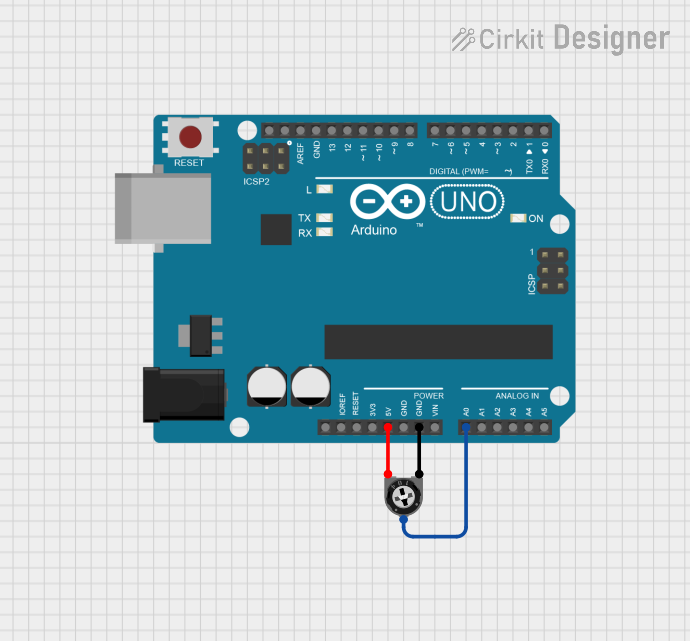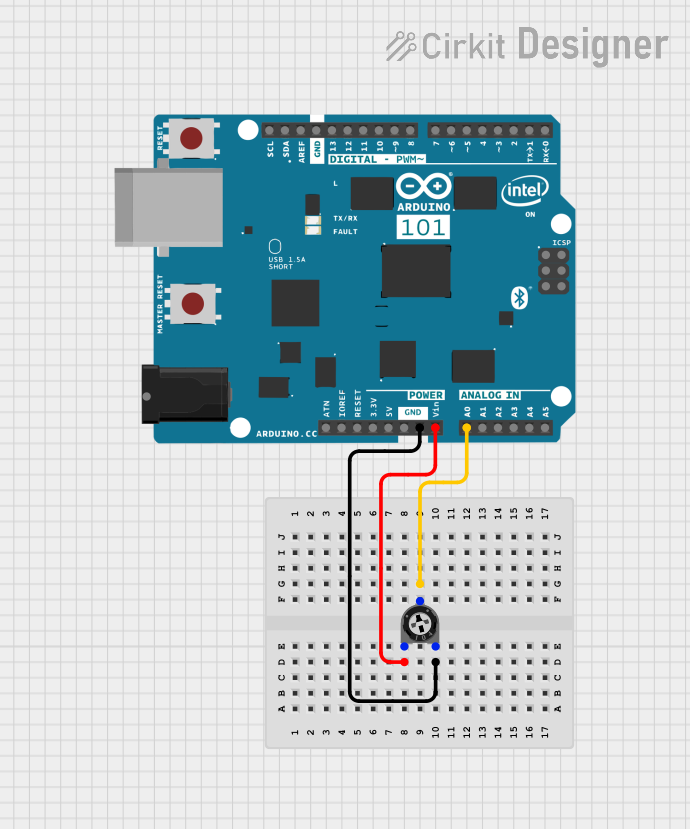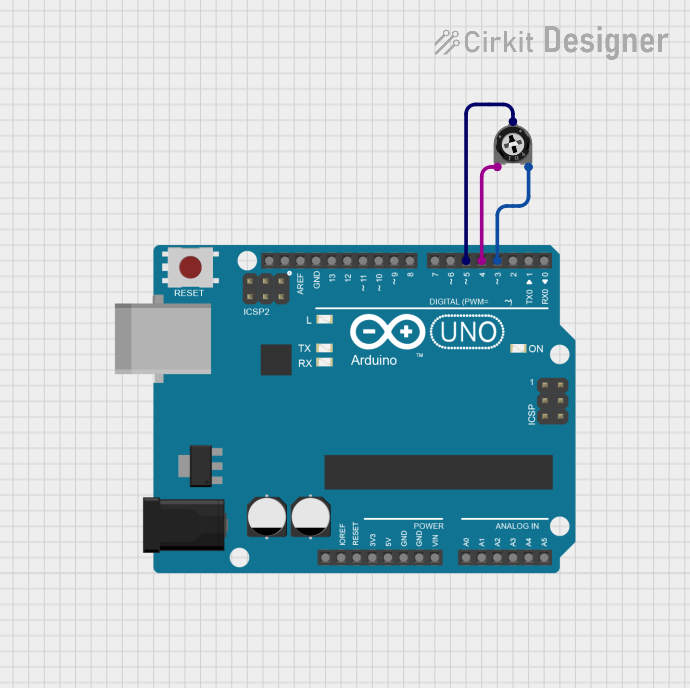
How to Use Trimmer Potentiometer: Examples, Pinouts, and Specs

 Design with Trimmer Potentiometer in Cirkit Designer
Design with Trimmer Potentiometer in Cirkit DesignerIntroduction
A trimmer potentiometer, often referred to as a "trimpot," is a small, adjustable resistor used to fine-tune or calibrate circuits. It allows for precise control of resistance values, making it an essential component in applications where accuracy is critical. Trimmer potentiometers are typically adjusted using a small screwdriver and are designed for infrequent adjustments.
Explore Projects Built with Trimmer Potentiometer

 Open Project in Cirkit Designer
Open Project in Cirkit Designer
 Open Project in Cirkit Designer
Open Project in Cirkit Designer
 Open Project in Cirkit Designer
Open Project in Cirkit Designer
 Open Project in Cirkit Designer
Open Project in Cirkit DesignerExplore Projects Built with Trimmer Potentiometer

 Open Project in Cirkit Designer
Open Project in Cirkit Designer
 Open Project in Cirkit Designer
Open Project in Cirkit Designer
 Open Project in Cirkit Designer
Open Project in Cirkit Designer
 Open Project in Cirkit Designer
Open Project in Cirkit DesignerCommon Applications and Use Cases
- Calibration of sensors and measurement devices
- Adjusting the gain in amplifiers
- Setting reference voltages in circuits
- Fine-tuning timing circuits
- Balancing bridge circuits
Technical Specifications
Below are the general technical specifications for a typical trimmer potentiometer. Note that specific values may vary depending on the model and manufacturer.
| Parameter | Specification |
|---|---|
| Resistance Range | 100 Ω to 1 MΩ (varies by model) |
| Tolerance | ±10% to ±20% |
| Power Rating | 0.1 W to 0.5 W |
| Adjustment Type | Single-turn or multi-turn |
| Operating Voltage | Up to 50 V (varies by model) |
| Operating Temperature | -55°C to +125°C |
| Lifespan | 200 to 1000 adjustment cycles |
Pin Configuration and Descriptions
Trimmer potentiometers typically have three pins. The configuration is as follows:
| Pin | Description |
|---|---|
| Pin 1 | One end of the resistive track (fixed resistance point) |
| Pin 2 | Wiper (adjustable resistance point) |
| Pin 3 | The other end of the resistive track (fixed resistance point) |
Note: The wiper (Pin 2) moves along the resistive track as the trimmer is adjusted, changing the resistance between Pin 1 and Pin 2 or between Pin 2 and Pin 3.
Usage Instructions
How to Use the Component in a Circuit
- Determine the Required Resistance Range: Select a trimmer potentiometer with a resistance range suitable for your application.
- Connect the Pins:
- Connect Pin 1 and Pin 3 to the circuit where the fixed resistance is required.
- Connect Pin 2 (wiper) to the point where the adjustable resistance is needed.
- Adjust the Resistance:
- Use a small screwdriver to turn the adjustment screw on the trimmer.
- Turning clockwise typically increases the resistance between Pin 1 and Pin 2 while decreasing the resistance between Pin 2 and Pin 3 (and vice versa).
- Test and Calibrate:
- Power on the circuit and measure the resistance or output to ensure proper calibration.
- Make fine adjustments as needed.
Important Considerations and Best Practices
- Avoid Over-Tightening: Do not force the adjustment screw beyond its limits, as this can damage the component.
- Power Rating: Ensure the trimmer's power rating is not exceeded to prevent overheating or failure.
- Stability: For applications requiring long-term stability, consider using multi-turn trimmers for finer adjustments.
- Mounting: Secure the trimmer properly on the PCB to prevent movement or damage during operation.
- ESD Precautions: Handle the component with care to avoid electrostatic discharge damage.
Example: Using a Trimmer Potentiometer with Arduino UNO
Below is an example of using a 10 kΩ trimmer potentiometer to adjust the brightness of an LED connected to an Arduino UNO.
// Example: Adjusting LED brightness using a trimmer potentiometer
// Connect the trimmer potentiometer as follows:
// - Pin 1 to GND
// - Pin 2 (wiper) to A0 (analog input on Arduino)
// - Pin 3 to 5V
const int potPin = A0; // Analog pin connected to the trimmer potentiometer
const int ledPin = 9; // PWM pin connected to the LED
void setup() {
pinMode(ledPin, OUTPUT); // Set LED pin as output
}
void loop() {
int potValue = analogRead(potPin); // Read the potentiometer value (0-1023)
// Map the potentiometer value to a PWM range (0-255)
int brightness = map(potValue, 0, 1023, 0, 255);
analogWrite(ledPin, brightness); // Adjust LED brightness
}
Troubleshooting and FAQs
Common Issues Users Might Face
No Change in Resistance:
- Cause: The adjustment screw is not being turned properly.
- Solution: Ensure you are using the correct screwdriver and apply gentle pressure while turning.
Component Overheating:
- Cause: The power rating of the trimmer is exceeded.
- Solution: Verify the power dissipation in the circuit and use a trimmer with a higher power rating if necessary.
Inconsistent Resistance:
- Cause: The trimmer is worn out or damaged.
- Solution: Replace the trimmer potentiometer with a new one.
Wiper Not Making Contact:
- Cause: Internal mechanical failure.
- Solution: Replace the component, as it cannot be repaired.
Solutions and Tips for Troubleshooting
- Always measure the resistance with a multimeter before and after installation to ensure proper functionality.
- If the trimmer potentiometer is not adjusting as expected, check for poor solder joints or loose connections.
- For critical applications, consider using sealed trimmer potentiometers to prevent dust or moisture from affecting performance.
By following this documentation, you can effectively use a trimmer potentiometer in your electronic projects for precise resistance adjustments and calibration.